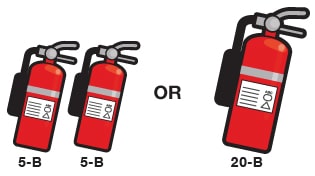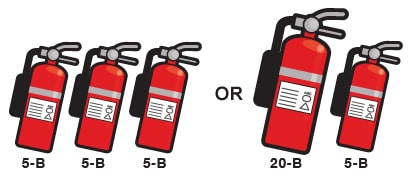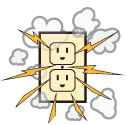Boat Fire Extinguisher Regulations, Classes & Maintenance
Boat Fire Extinguisher Regulations
It's time to introduce the next important piece of safety equipment on your boat: the fire extinguisher.
Important
Effective April 20, 2022, any non-rechargeable (disposable) fire extinguisher that is older than 12 years should be removed from service. Refer to the date of manufacturing stamped on the bottle; for example, "05" means "2005."
You are required by law to have a fire extinguisher on board if your boat has an engine and meets any of the following conditions:
- Your boat has closed compartments where portable fuel tanks may be stored.
- Your boat has a double bottom that is not sealed to the hull and that is not completely filled with flotation materials.
- Your boat has closed living spaces.
- Your boat has permanently installed fuel tanks.
- Or if your boat has any inboard engine.
It is not required by law to carry a fire extinguisher on other types of boats but it is still highly recommended. Fires can happen unexpectedly and it's always a smart idea to be prepared.
Important
The following information is effective April 20, 2022.
Vessels that have a model year of 2018 and newer may carry only 5-B or 20-B rated fire extinguishers with date stamp.
Vessels with a model year between 1953 and 2017 may carry either:
- Unexpired 5-B or 20-B rated fire extinguishers.
- Or B-I or B-II rated fire extinguishers that are in good and serviceable condition.
When required by the USCG, fire extinguishers must be on board a vessel and readily accessible—where they can be easily reached. When deciding on a place to store a fire extinguisher, make sure to consider how easy it is to reach in the event of a fire. It is recommended that the fire extinguisher be conspicuously and securely mounted on its intended hanger or bracket.
Now, let's quickly review the number of and types of fire extinguishers you need on your boat.
- If your boat is less than 26 feet, you need one 5-B fire extinguisher on board.
- If your boat is between 26 and 40 feet, you need either two 5-B fire extinguishers or a single 20-B fire extinguisher.
- And finally, if your boat is between 40 and 65 feet, you need either three 5-B fire extinguishers or one 20-B fire extinguisher and one 5-B fire extinguisher.
If your boat is longer than 65 feet, check the federal regulations.
| Boat Length | Extinguisher Requirement |
|---|---|
| Less than 26 ft. |

|
| 26 ft. to less than 40 ft. |

|
| 40 ft. to less than 65 ft. |

|
| Greater than 65 ft. | Must meet federal requirements |
| Inboard engines | When the engine compartment is equipped with a fixed (built-in) extinguishing system, one less 5-B extinguisher is required onboard. |
Note: One 20-B portable fire extinguisher may be substituted for two 5-B portable fire extinguishers. For vessels with a model year between 1953 and 2017, one 20-B/B-II portable fire extinguisher may be substituted for two 5-B/B-I portable fire extinguishers.
Glossary
model year
The period beginning June 1 of a year and ending on July 31 of the following year and being designated by the year in which it ends
Fire Extinguisher Classification
Fires are classed depending on their fuel source: solid, liquid or electrical. Each fire burns differently and requires a specific type of extinguisher. That's why every fire extinguisher is marked with a letter, like A, B or C. The letter indicates both the class of fire extinguisher and the class of fire it is designed to put out.
Fire Types Are:

CLASS A: Combustible solids

CLASS B: Flammable liquids

CLASS C: Electrical fires
Class A fires have a solid combustible fuel source like wood or paper. You can use water, or a Class A fire extinguisher, to put out this type of fire.
Class B fires, on the other hand, have a flammable liquid fuel source, like gasoline. Do not use water to put out a Class B fire as it will just spread the fire. Instead, use a Class B fire extinguisher.
Finally, a Class C fire is an electrical fire. Like a Class B fire, never use water on a Class C fire. Use a Class C fire extinguisher.
Because gasoline fires are the most common type of boat fire, marine-rated Class B fire extinguishers are the class required on most boats. The number before the B, for example a 5-B or 20-B extinguisher, indicates the square footage of the fire the extinguisher can put out.
It's important to note that you can also get fire extinguishers that put out multiple types of fires. A Class ABC fire extinguisher, which can handle all fires, is therefore the most recommended class of extinguisher.
There are different types of fire extinguishers, with the most common being a dry chemical extinguisher.
Boat Fire Extinguisher Maintenance
Extinguishers must not be expired or appear to have been previously used. They must be maintained in good and serviceable condition. Good and serviceable condition means that the fire extinguisher on board:
- Is charged and indicates it is charged if the extinguisher has a pressure gauge reading or indicator.
- Has a pin lock that is firmly in place.
- Does not show visible signs of significant corrosion or damage.
- And has a discharge nozzle that is clean and free of obstructions.
A monthly inspection of your fire extinguisher should be a part of your regular boating maintenance. This will make sure your extinguisher is always ready to go in the case of an emergency.
Include the following steps in your monthly boat fire extinguisher inspection:
- First, check the gauge to make sure it is still fully charged.
- Next, look at the seals to make sure they have not been broken.
- Then inspect the hose to make sure it is not cracked or broken; and replace it if you find it's not in good condition.
- Last but not least, for dry chemical extinguishers, weigh your extinguisher to make sure it meets the minimum weight specified on the label.
Done! Your fire extinguisher is good to go for another month!
| Classification | Foam (gal.) | CO2 (lbs.) | Dry Chem (lbs.) |
|---|---|---|---|
| 5-B | 1.25 | 4 | 5 |
| 20-B | 2.5 | 15 | 10 |

